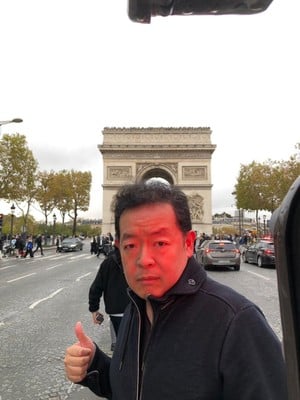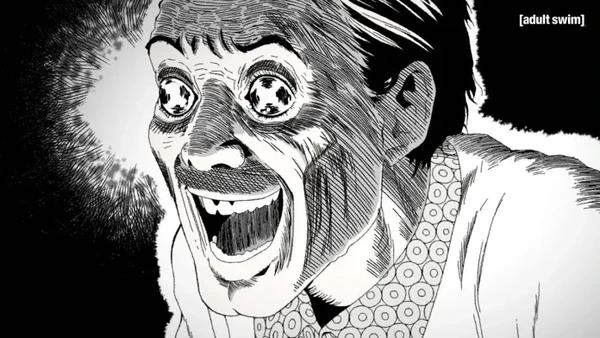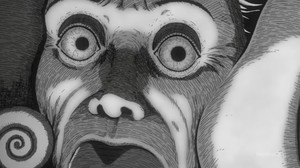Director Hiroshi Nagahama, From Wicked City to Uzumaki
by Dawn H.,
On the screen in front of a crowded Otakon panel room, Director Hiroshi Nagahama shows a slide featuring the cover art for the 1987 film Wicked City, directed by Yoshiaki Kawajiri of Studio Madhouse on the screen in front of a crowded Otakon panel room. Several audience members reacted, and Nagahama asked, "Do you know this? Who here has seen this movie?" To his surprise, a good number of audience members raised their hands. Nagahama explains that he first saw the film when he was only 16 years old, and it profoundly affected him.
Back in the days of VHS video rental stores, he and his high school friends would look for the weirdest anime they could find to rent and watch together. Wicked City scared them. "I never thought that pictures drawn by people could be so horrifying," he recalled to the audience. "And watching this made me want to enter the studio that created this, Madhouse, and become an animator." Indeed, he would eventually live this dream, starting from the bottom as an in-between animator on Madhouse's anime adaptation of Yawara! A Fashionable Judo Girl in 1989. But it was a long, hard road to get where he is today. From the grueling work schedule of the original Record of Lodoss War OVA to working on the enigmatic Revolutionary Girl Utena, Hiroshi Nagahama eventually made a name for himself in the industry and was able to direct some of the most beautifully haunting anime in recent years: Mushishi and The Flowers of Evil.
With this background, it's no surprise Production I.G USA asked him to work on an anime adaptation of one of the most popular modern horror manga, Junji Ito's Uzumaki, in 2019. Now, five years later, the four-episode anime series is slated to premiere in Japanese with English subtitles and dubbed on Cartoon Network's Adult Swim on September 28—just in time for the Halloween season. I talked to Nagahama at Otakon 2024 and asked him a few questions about the show and its production.

ANIME NEWS NETWORK: The anime adaptation of Uzumaki has been a long time coming. How did you initially get started with the project?
Hiroshi NAGAHAMA: Jason [DeMarco], the Cartoon Network producer--he's also a big fan of Uzumaki. He communicated with Terashima, the President of Production I.G USA, [Maki] Terashima. So, as the project moved forward, Terashima contacted me, saying, "Are you interested in doing this?"
Were you a fan of Junji Ito's manga before starting the series? Which of his manga made the biggest impact on you?
NAGAHAMA: Oh, yes. I'm a huge fan. But Uzumaki is a long manga, and I hadn't read it before. I was more of a fan of his collections of short stories. I'm not sure what the English titles are, but they're The Long Dream, Alley, and Shiver. I'm a huge fan of those.
Ah, those are good! The Long Dream is a very good one.
NAGAHAMA: I love it. It's like...the human body, how it changes and transforms. It's scary but also beautiful. I like how it gives me very indescribable feelings.
From what I've seen your social media team posting online, it looks like Junji Ito has been extremely involved in the process of Uzumaki's creation. How was he involved with the process? And were there any scenes he wanted the team to focus on?
NAGAHAMA: Not sure how much I can say. There are some restrictions, but there are some things that I can say clearly...So it takes place in a city called Kurouzu. He [Junji Ito] produced a map of the city where the spirals were located and where the train lines run. He went over it with me to check and make sure that everything was in the correct locations. The character Azami has a spiral on her face. So, how the spiral moves and at what speed were some details that I went over with him.
I was impressed that Colin Stetson was chosen to work on the soundtrack as he's recently done great work with horror movies like Hereditary and Color Out of Space. How was he brought onto the series?
NAGAHAMA: So Jason [DeMarco], the producer at Cartoon Network, suggested Colin, and when he asked, "What do you think?" Mr. Stetson said, "Oh my God, that'd be awesome!" It turns out that Colin Stetson was also a big fan of Junji Ito and Uzumaki, so it miraculously came about.
Oh, that's wonderful! Are you a horror fan yourself? Do you have any favorites that have inspired you while working on Uzumaki?
NAGAHAMA: Yes! Ah, there's so many! For Japanese films, Ju-on [The Grudge], and Kairo [Pulse]. Junji Ito also gets inspiration from films that have grotesque human body transformations, like The Fly, so I also like to watch those films.
Has there ever been anime or manga that scared you?
NAGAHAMA: Yes! Wicked City. With the Spider woman!
Oh yeah! With the big, long legs?
NAGAHAMA: Yes! That was scary.
Ah, Kawajiri...
NAGAHAMA: Yes! [Yoshiaki] Kawajiri is one of the directors I respect the most.
Horror anime doesn't seem to be made as often as it used to be. Do you think it's not seen as "trendy" now as other genres these days?
NAGAHAMA: It's not that it's not trendy, but when it's lines drawn by a human hand and done in the medium of anime, it makes it more obvious that it's fiction and that it's not taking place. So I don't think it's very suited for horror. To be a horror, it has to be very specialized. A different look, like more detailed line work, maybe. It has to look different from regular anime, right? And that costs a lot.
Why was CG animation a good fit for Uzumaki? What techniques did you use to bring Ito's manga to life?
NAGAHAMA: It can't be disclosed right now, so you have to wait for it to come out. But we were aiming for something where you look at it and go, "How did they do that?!" Or "What were they doing?!" so that's what I was going for.

When you worked on Flowers of Evil, rotoscoping techniques gave the series a distinct look. This time, you're making a series entirely in black and white. How did you choose to stick to a monochrome look throughout the entire series?
NAGAHAMA: I've always wanted to work with black and white, but with the Japanese animation industry, they just won't let you because people would be wondering if something's wrong with their TV. But Jason [DeMarco] said, "Sure, go ahead!" So I said, "Really? Yay, let's do it!"
I think it's great that the anime storyboards are using panels from the original manga, but something I like about anime is seeing someone else interpret the manga. Can we still expect to see some surprises and artistic flair in Uzumaki while still staying true to the spirit of Ito's original work?
NAGAHAMA: So...yes, while the storyboards use pasted panels of the original manga, there's different stuff involved in the making of the anime that is kind of like a fake out. It's a surprise.
Fans have already noticed that there's more detail in the most recent trailers for Uzumaki than the ones you first showed five years ago. So it's obvious that there's already been a lot of improvement with the time that you had. How important was it to you to make sure you gave your staff that time?
NAGAHAMA: From the beginning, we knew what direction to take, but it was difficult to get there, to reach what we imagined. So we just had to keep adjusting to reach that vision.
Thank you again for taking the time to talk with us today. Do you have anything you'd like to say to Uzumaki fans before they watch the series?
NAGAHAMA: Let's see...I want people to know that making anime is a group effort and that so many people were involved in Uzumaki. They gave so much of their time and put so much effort into giving life to Junji Ito's manga. Please keep that in mind when you watch it.